Japanese Design Archive Survey
DESIGN ARCHIVE
Designers & Creators
Seiju Toda
Art Director
Interview: 9 June 2024, 10:00-12:00.
Location: Brilliant Heart Museum
Interviewee: Seiju Toda
Interviewers: Keiko Kubota, Yasuko Seki
Author: Yasuko Seki
PROFILE
Profile
Seiju Toda
Art Director
1948 Born in Fukui Prefecture
1970 Joined Takashimaya Advertising Department
1973 Joined Nippon Design Center
1976 Established Toda Office
2015 Established Lightoda
2018 Brilliant Heart Museum opened in Sakai, Fukui

Description
Description
After the 1960s, when Japanese advertising design blossomed, the 1970s-90s, when advertising design shone brightly and mass media such as television, magazines and newspapers exerted great influence, art director Seiju Toda introduced a number of advertising campaigns to the world that took Japanese advertising design to a new level. In other words, it can be said that advertising design made the leap from ‘commercial design’ to ‘visual art’ with the advent of Toda. Toda's masterpiece, Suntory Royal, brilliantly visualised the mysterious world of French poet Rimbaud and Spanish architectural genius Gaudi, and sublimated it into a high-end whisky advertisement with its overwhelming impact.
Toda's advertisements are characterised by the expression of ‘something’ that transcends logic and explanation and shakes the very foundations of human nature. What is it? Kazumasa Nagai, who recognised Toda's talent stated that ‘modernity, artistry and challenge have consistently flowed into Toda's subsequent designs’ (Seiju Toda Art Direction, published by Rikuyosha). For Toda, design and art are indistinguishable domains in the act of ‘creation’.
Toda's base of operations is the Brilliant Heart Museum, which he founded in his hometown of Sakai City, Fukui Prefecture. This museum can be described as a real challenge to the modernity (a focus on nature and the environment, and a departure from the city) and artistry (the new field of the museum) that Nagai pointed out runs through Toda's creations. At the age of 70, Toda is embarking on a second life as a creator. Having ‘hunted the edge of the times’ in the metropolises of Tokyo and New York, the hunter is now sowing various ‘seeds of design for the future’ in his new base overlooking the Sea of Japan.
This time, we spoke to Mr Toda himself at the Brilliant Heart Museum about his archive and the source of his creativity.
Masterpiece
Masterpiece
1976 “Junrock” Japan campaign, Takara Shuzo
1979 Canned Beer Campaign, Suntory (-81)
1982 Canned Beer "Penguin's Bar" Campaign, Suntory (-84)
1982 "Suntory Royal" campaign, Suntory (-84)
1983 PARCO fashion campaign and logo, PARCO (-87)
1986 Isetan fashion campaign and CI, Isetan (~95)
1988 Cover art direction for “AERA” magazine, Asahi Shimbun (-2014)
1994 Akira Kurosawa Drawing Exhibition, curation (toured until 2010)
1995 Enshu Kobori 350th Anniversary Exhibition, curation, MOA Museum of Art
2003 Roppongi Hills Opening Campaign, Mori Building, Collaboration:Takashi Murakami
2008 Art direction for Hokkaido Shikotsu-lake Summit venue
2006 Wim Wenders photography exhibition and collection, Asahi Shimbun, Spoon
2017 Milano Salone 'Light House' booth direction
2017 Direction of products with Ainu patterns, Marui Imai
Art activities
1995 X=t
2003 HEIAN
2016 Lightface
Book
“Tokyo Grafica-2" Rikuyosha (1991)
“X=t The Art of X-Ray Photography" Hudson Hills Press/ USA (1995)
ggg Books 33 "Seiju Toda" Ginza Graphic Gallery (1997)
“Seiju Toda's Design World" Guangxi Art Publishing House/China (2000).
“HEIAN" Hudson Hills Press/ USA (2003)
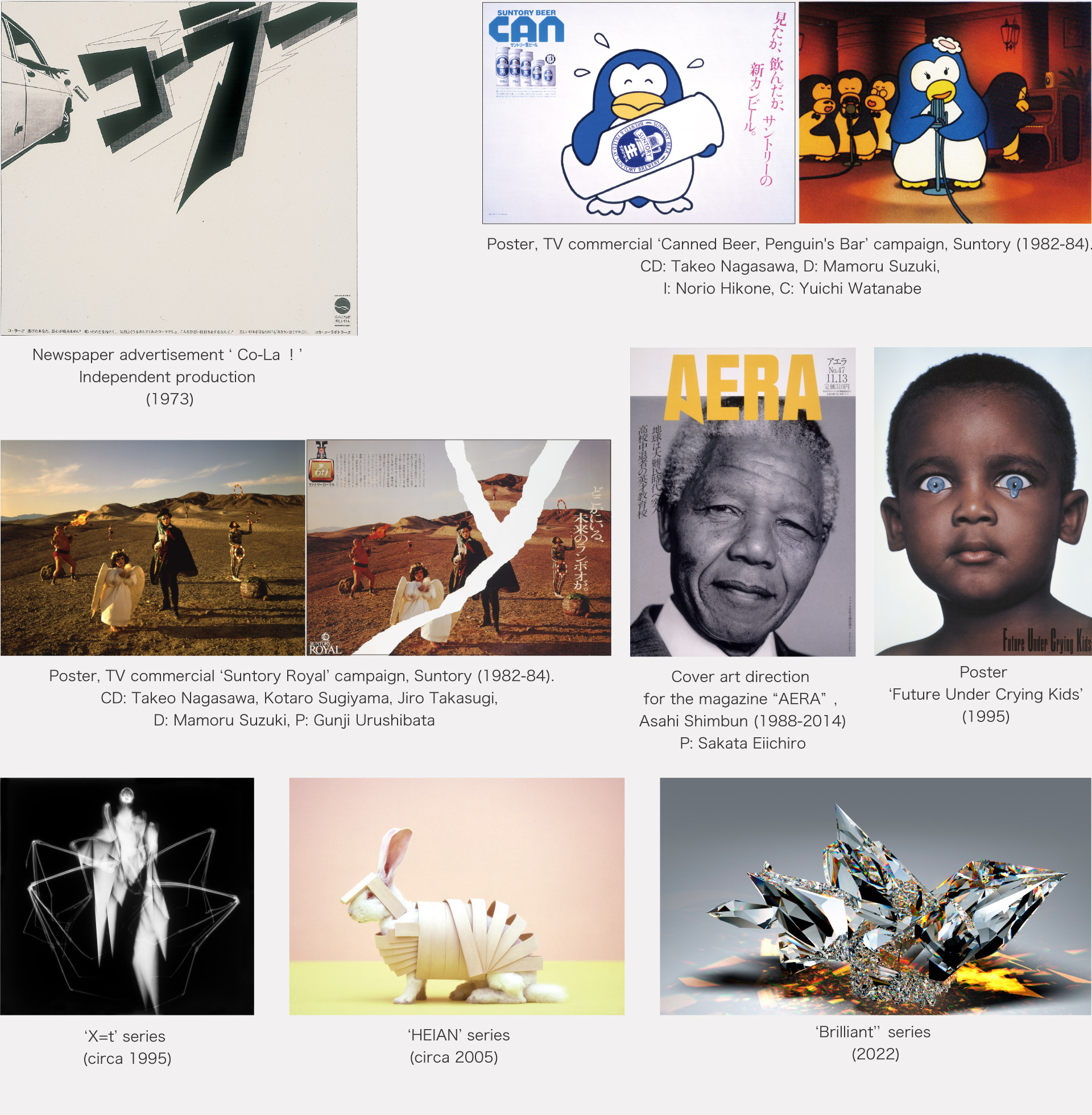
Interview
Interview
Betrayal is life, happy betrayal is the source of creativity.
Museums built in hometown
ー As an art director, you continues to be on the edge of the times. Today we are interviewing you at the Brilliant Heart Museum, which you founded in praivate. First of all, I would like to ask you about the background to the idea of creating this museum.
Toda Here in Mikuni, Sakai City, Fukui Prefecture, is my hometown. And Oshima Island, which you can see from the museum, is a place that has had a great influence on my life. Going back in time, there was a wealthy merchant family in Sakai City called the Morita family, who were known as collectors of contemporary art. When I was a high school student, the filmmaker Idemitsu Mako and her partner, the American artist Sam Francis, came to Sakai and I showed them around Tojinbo and Oshima with the Morita family son. Mako was impressed by the beauty of Oshima and I thought that there was something about Oshima that appealed to artists, and as I was turning 70 and thinking about trying something new, it suddenly came back to me.
ー Why did you decide to create a museum?
Toda I never had the idea of creating a retrospective exhibition or collection of my own work. I wanted to do something that looked to the future rather than looking back to the past. Then I decided to create a museum on the theme of nature and the environment on the island of Oshima, which I had been interested in since high school.
ー I think it is normal for a designer of your caliber to think about creating a museum or archive to exhibit your work.
Toda I definitely didn't want to do that. I was determined not to do.
ー What is happening to Toda's work and materials now?
Toda They are being organised and stored in a rented warehouse. I am currently being consulted by a museum in Hong Kong about an exhibition. If I receive such an offer, I will respond accordingly, but I am not actively thinking of doing it myself. I want the Brilliant Heart Museum to remain here rather than my own work.
ー But wasn't it an adventure to take on a new challenge in your hometown after 50 years?
Toda Of course I couldn't have done it alone. I was finally able to complete the project with the understanding and cooperation of Masao Morioka, who runs a pension and restaurant here, his wife, Chiyoko, who is also an artist and the local people.
ー It's a wonderful location overlooking the island of Oshima. Once we step into the museum, we can feel your attention to detail in every corner.
Toda Here, I searched for a plot of land with a view of only Oshima, the sea and the sky, designed the building and designed the exterior to blend in with the landscape of a traditional fishing village. There are only three exhibits: a magnificent view of Oshima and the Sea of Japan framed by large windows, objects made from my collection of Jomon pottery shards, and a video showing the ever-changing landscape of Oshima. In addition, there is a feast of light created by a prism called “Seiju Cut”, which I developed myself. The main attraction of this museum is that it allows visitors to experience and appreciate time, seasons and the changing nature in its entirety.
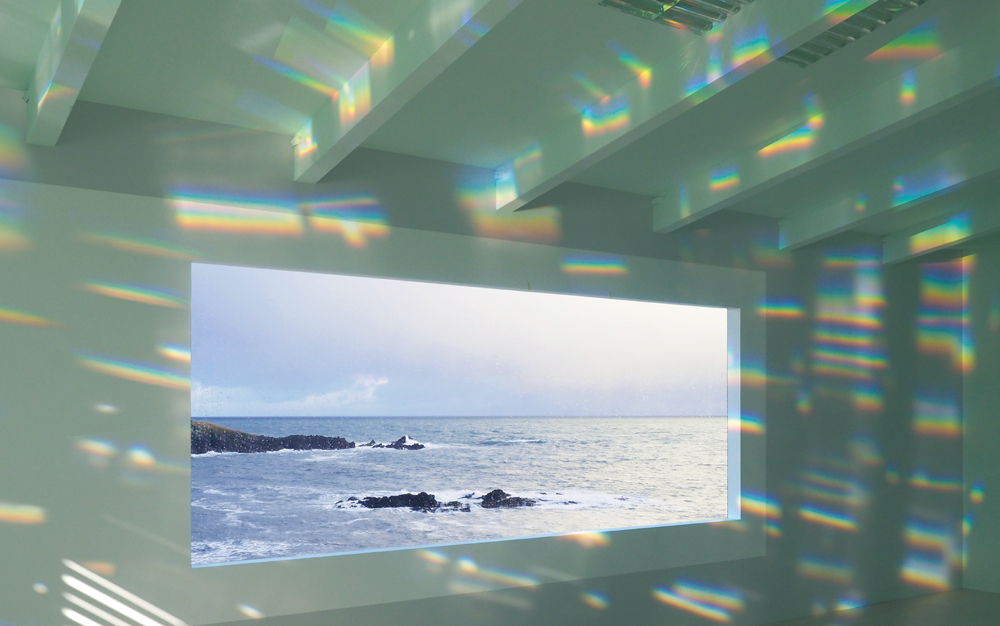

Large windows overlooking Oshima and the Sea of Japan. Daytime and evening views.
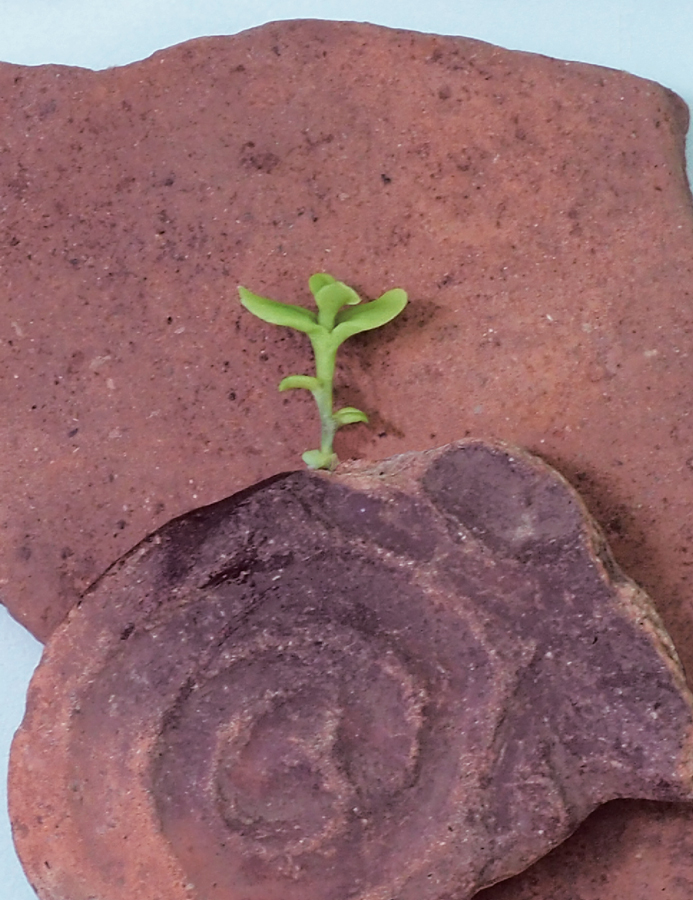
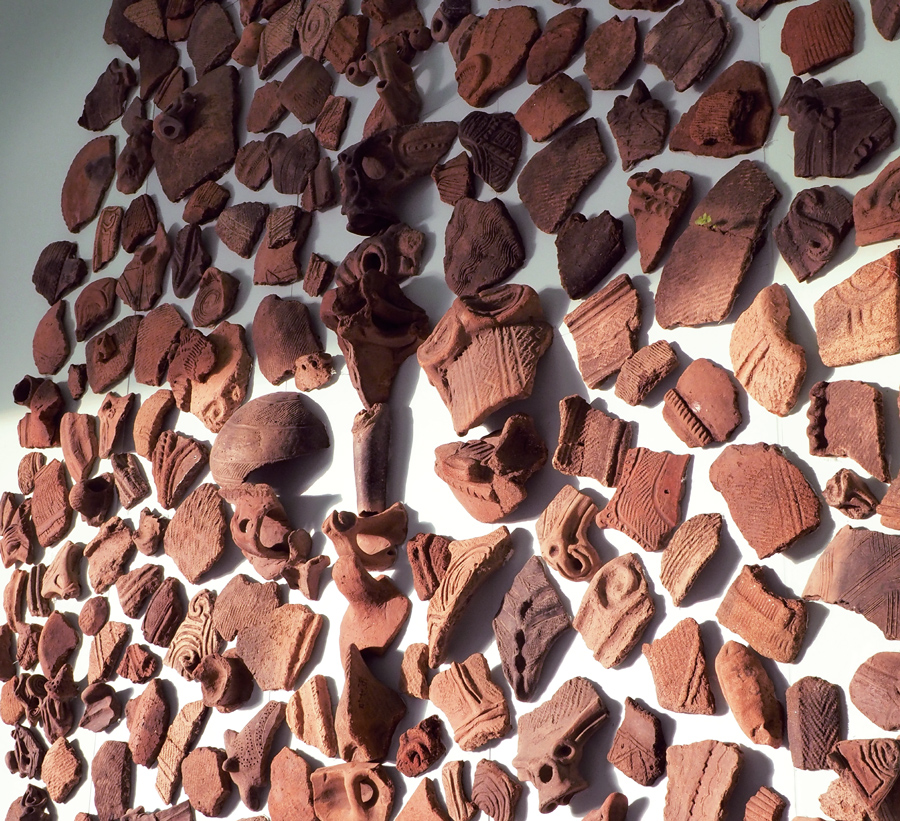
S Objects made from reused pieces of Jomon pottery. The plants were created by Chiyoko Morioka.

Brilliant space created by ‘Seiju cuts’.
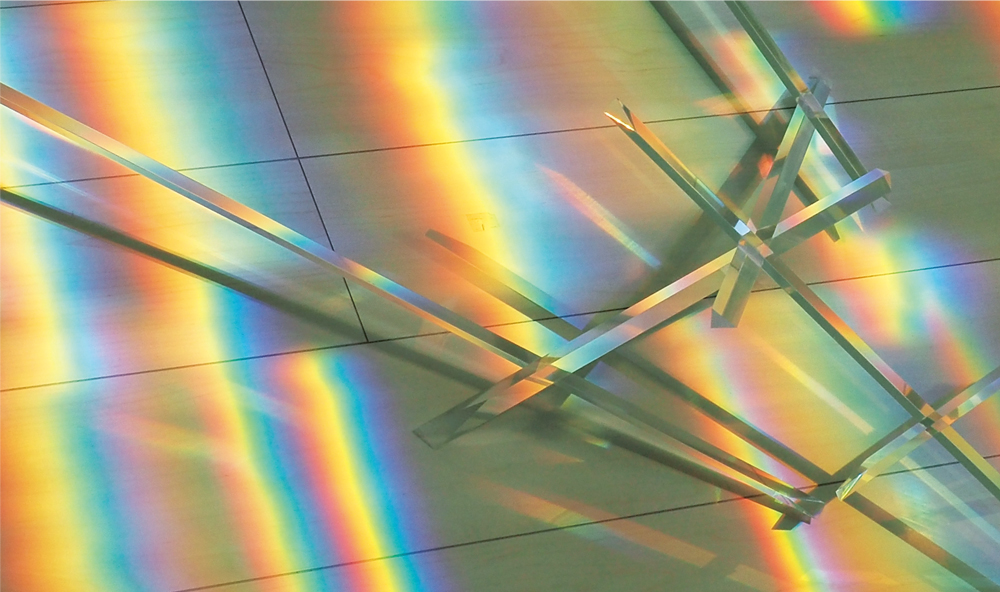
3 types of Seiju cuts developed by Mr Toda as part of his personal activities, which he has also patented.
ー Can you tell us a little more about the 'Seiju Cut'?
Toda It is an object with a prismatic effect that creates a beautiful rainbow when illuminated. The production process was created with support of engineers, and the shape was derived from computer calculations. There are three different types of Seiju Cut, each of which produces a different rainbow. I have been working as an art director for a long time, but I have invented unprecedented 'objects' for the future, so I incorporated them into this museum space to create a unique space.
The road to becoming a designer
ー I would like to ask you about your path to becoming a designer.
Toda The most important encounter was with Tadahiro Ono, an artist and my art teacher in high school. He was from Aomori Prefecture and was known as an avant-garde artist. However, in addition to his activities as an artist, he taught art at Mikuni High School in Fukui Prefecture, where I went to school, and was also a part-time lecturer at Fukui University. I was interested in art and had heard of his reputation, so I joined the art club.
ー Do you have any episodes with him?
Toda Some time after I joined the club, he told us that the art club was going to submit a work to the Fukui Prefecture General Art Exhibition, so I drew an avant-garde picture in the style of Tadahiro Ono on plywood and nervously showed it to him. Then, to my surprise, he kicked my work out of the school building in the rain. When I picked up my work, soaking wet, he said, "Your work was better than before, wasn't it? I was stunned and moved, and stood there in a daze. This incident brought me an epiphany about what art is.
ー Were there any other influences from him?
Toda He was like a 'window' who showed me new worlds. He was in contact with Taro Okamoto and other artists of his time, and sometimes went to Tokyo to talk to us about the exhibitions and concerts he had seen. He also taught us the wonders of art, such as Rambo for literature, Le Corbusier and Gaudi for architecture. During the sensitive period of my high school years, I received an artistic revelation from Mr Ono, which is the basis of my creativity.
ー Did you go to Tokyo to study design?
Toda Yes. I entered the newly established Tokyo Design College (now Meguro Seminar) on recommendation. Other people associated with this school included Osamu Tezuka, Yusaku Kamekura and Ryuichi Yamashiro. In1966, I entered the school and studied graphic design from my second year, but my designs were too avant-garde and were not well received. At one of the cultural festivals, I exhibited a conceptual artwork entitled ‘Buckets of water become drops of water’, which was appreciated by Ms Tezuka and Mr Yamashiro. Mr Yamashiro introduced me to an art gallery in Ginza and I was even able to hold my first solo exhibition. This changed my reputation at school and my confidence as an artist grew.
ー What made you shift from thinking about art to design?
Toda Actually, I applied to Nippon Design Centre when I graduated, but I failed. Mr Yamashiro found out and recommended me to Takashimaya's advertising department. However, when I entered Takashimaya, I was surrounded by talented people who had graduated from art universities, while I was constantly scolded for being too art-oriented. So, aiming to turn things around, I entered the Asahi Advertising Award, which was an authority in the industry, and won the Grand Prix on my third attempt.
ー What kind of work was it?
Toda The subject is Coca-Cola. The layout was done in a Lichtensteinian style, with photos of empty Coke cans being thrown from cars and the words ‘Co-La!’. We used the Coke and the words 'Co-La!' with wit, and the jury thought the idea was brilliant. When Kazumasa Nagai of Nippon Design Centre saw it, he invited me to come to his company. I was very happy.
ー So you joined Nippon Design Centre in 1973.
Toda I worked with three assistants on jobs for Isetan and other companies, but after three years, in 1976, I became independent. However, I continued my art activities while working as an art director.
ー Why did you choose design instead of art?
Toda Because I didn't want to be poor. No matter how famous and respected you are, it's not easy to make a living as an artist. That's why I chose design, where I could combine expressive activities with earning money.
ー But you also continued your art activities afterwards, didn't you, Toda?
Toda Yes. I held art exhibitions in New York and Seoul and made some collections of my work. Looking back, the 1980s and 1990s were a privileged time. There were individuals and companies that sponsored our art activities, and I think the respect for the act of creation was higher than it is today.
Designing 'betrayals that surprise'
ー I was reading a book and there was a line that said that the essence of Toda's work is betrayal that surprises! I thought, "This is it! Since becoming independent, you have created many advertisements that have made people around the world gasp in surprise, and I think this is exactly what you mean.
Toda That's the essence of art, isn't it?
ー I would like to explore the secrets of your creations through some of your best-known works, with these words as the axis.
Toda In my work, the Suntory Can- Beer 'Penguin Character Edition' was the first project in which I was conscious of betrayal. In fact, for three years before this series started, I was in charge of advertising for the same Suntory canned beer, and we ran a campaign based on the concept of 'drinking beer in cool'. It worked, and Suntory canned beer increased its market share from 3 to 8 per cent in three years.
ー From ‘Cool’ to ‘Penguin' is indeed a betrayal.
Toda Yes. In the background, there was an expansion of the target from big cities to the whole of Japan. Therefore, when I was worried that art would not work this time, I suddenly realised something. In my room full of art, I found a calendar of yuru-characters by Norio Hikone, who was known for his drawings of "Manga Nihon Mukashi Banashi". I thought, "This is it!” I had a flash of inspiration. At the presentation the next day, I pulled out a sketch of a penguin from my breast pocket and ....... After a moment of silence, the person in charge said, "Let's go with this". This is betrayal, isn't it?
ー I would like to ask you about the ‘Suntory Royal’ advertisement, which completely betrayed the image of conventional advertising.
Toda Dentsu planner Kotaro Sugiyama wanted me to do whisky because of the success of their beer advertising. It was Royal, a luxury whisky for gift-giving, which was displayed on the sideboards of ordinary households. The concept of this advertisement was that in order to increase sales of Royal, it had to be taken off the sideboard and drunk more. The direction was commissioned from Jiro Takasugi.
ー How did you end up with Rimbaud and Gaudi?
Toda It was already a simple idea: if it's a luxury product, it's art, let's make people remember it, raise its profile and get them to drink more and more of it. Then, I came up with the idea of working with Dentsu to create an advertisement using the motifs of Rimbaud, the poet and architect Gaudi, whom I met and loved in high school, and others.
ー When I first saw the Rimbaud ad, I was just shocked. Where did that visual image come from?
Toda The Fellini film “8 1/2”.
ー Newspaper advertisements were designed with daringly torn designs. That was shocking too.
Toda The film was shot on location in the suburbs of Las Vegas, USA, and all the cameramen and characters were American. It was a beautiful 15-page newspaper advertisement, but it lacked a bit of impact. So I ripped up the advertisement and to my surprise, it was good. This is also betrayal, isn't it? Betrayal is life, and betrayal is the source of creativity.
ー How did you get involved in the art direction of Asahi Shimbun's magazine “AERA”?
Toda ”AERA” was attracting attention as a weekly magazine to replace ”Asahi Journal”, and I was asked to do the art direction. I joined the team and the seven members met regularly to discuss the magazine's title and content. I said, "Let's ask a professional wordsmith" for the title, and we decided on copywriter Jun Maki. He suggested the title 'AERA', which means 'era' in Latin, and it matched the acronym for the concept of 'Asahi shimbun Extra Research and Analysis', so we settled on AERA.
ー The cover of “AERA” was a simple design, a portrait of a person who symbolised the era, and it has remained unchanged.
Toda I had the cover of the American magazine ”TIME” in mind. I thought that ”AERA” had to be a magazine that betrayed the hard-core image of the “Asahi Journal”. So we proposed that we wanted to light the iconic figures of the times in a studio and shoot them in black and white with a 4×5 camera as if they were portraits. Then the idea of using in-house photographers to take the pictures came up, and I recommended Eiichiro Sakata, who had trained in New York.
ー Did you make the final adjustments to the portraits yourself?
Toda That's right. It was my job to improve the negatives that Mr Sakata had given me, saying "take care of the rest". The portraits were everything for the cover, and it was my role as art director to bring out the wonderful expressions on the faces of the people who appeared on the cover.
ー What were the criteria for your decision to go with this?
Toda For the cover of “AERA”, I didn't choose whether I liked it or not, but whether it was good or bad. I have my own tastes and preferences, but as an art director it is important to judge objectively.
ー Your work is a collaboration with talented people, for example, where you work on a project while excitedly betraying each other.
Toda For the Isetan campaign that started in 1988, I teamed up with a photographer called Steven Meisel, who works in New York. However, two or three days before the shoot, he suddenly said he wanted to change the model. Everyone told me that it was impossible and that I should refuse, but I took Meisel seriously, consulted the Isetan manager in charge, got the OK, and we did the shoot. Actually, Meisel brought along Naomi Campbell, who was on the verge of her breakthrough. She became a super success a year later, and Isetan's reputation for using her quickly rose. This was probably another success brought about by betrayal.
ー You took over the PARCO campaign from Eiko Ishioka.
Toda I took over from her when she left for the USA, but the challenge was how to collaborate with the illustrator Harumi Yamaguchi. I thought about it a lot and decided not to leave everything to her, but to ask her to draw pictures tracing the photographs I had taken with my image. I asked Yamaguchi to draw super-realistic illustrations of the photographs I had taken in New York, which I then silk-screened to a white colour to create the poster.
The message of PARCO created by Ms Ishioka in the 1970s was strong. But times changed, the image of women changed, and Parco's image had to change. That's why I asked Ms Yamaguchi for a different kind of expression from that of her time. When I met her afterwards, she told me that this work led to different requests coming in.
ー The opening campaign for Roppongi Hills using Takashi Murakami was also your work, wasn't it?
Toda On Valentine's Day 2002, I received a phone call from Mr Maki asking about a competition. That's when I suggested that we collaborate with the artist Takashi Murakami. Roppongi Hills was art-oriented, and Murakami's style goes well with graphics, so I had a hunch that he would fit the image perfectly. The proposal was accepted and I became involved in the project as art director.
>
Connecting design to the future
ー You were based in Tokyo and New York for a period of time, weren't you?
Toda I think it was from 1990 to 2003. I was an art lover and I was working as an art director and creating art at the same time, so Tokyo was a place of work and New York was a place of play and creativity. In New York, art and culture are valued and stimulating, and the art world is always churning. The location was around 38th Street at Fifth Avenue. It was a very privileged location, with Union Square and Washington Square nearby and Soho within walking distance. I had a big room and used it as my studio and home. But in 2001, '9/11' happened and I decided to move out. Good memories.
ー What kind of activities did you do in New York?
Toda In 1994, I organised an exhibition of drawings by director Akira Kurosawa. The exhibition was covered by the New York Times and became a hot topic, and it was good to be able to compile a catalogue of his work for the exhibition. Then in 1995, I had an exhibition at the Atrium Museum of Art, Chicago, of my artwork X=t, which used x-ray photographs, and I published a book of my work.
ー What was behind your starting something new at the age of 70, and what did you think about current design?
Toda I think that too many amateurs participate in creativity and that we need to ask more professionals. It's great that anyone can create with the development of digital technology, but on the other hand, we are losing respect and esteem for professionals and professions. You have to be a professional to do inspiring work. For me, current creation and design is characterless and uninteresting.
ー Is there a lack of 'surprise and betrayal'?
Toda That could also be translated as 'emotion'.
ー Having heard your story, Toda's very path is "a betrayal with a surprise". You are now organising the 'Hokuriku Triennial of Contemporary Art for High School Students in the Three Prefectures of Hokuriku' in order to create the creativity of the future?
Toda I myself am where I am today thanks to the many encounters and challenges I have had. That's why I decided to create opportunities for young people to meet and challenge themselves. The Art Biennale targets high school students from the three prefectures of Toyama, Ishikawa and Fukui, and invites them to create installations in historical places in Sakai City, which will be judged by famous creators.
ー You describe the aim of the project on the website as follows. The young people who participate in this Biennale will discover their own unknown strengths and talents and use them as a starting point. Believing in their unlimited potential".
Toda I myself gained confidence when so many people recognised my talent.
ー What do you want to do after the Brilliant Heart Museum and Art Biennale?
Toda One thing I want to do is to build a church. I am not a Christian, but I think the church Matisse built in his last years is his masterpiece. The second is a museum without artworks.
ー What kind of image do you have of a museum without artworks?
Toda About 20 years ago, My friend asked me for advice on a gift for Microsoft's Bill Gates. Gates was a collector of da Vinci manuscripts, so I made a business card using da Vinci's mirror script and gave it to my friend. The friend later told me that Gates was delighted and would treasure the card. So, for example, in the digital age when all we have are fonts, it would be interesting to exhibit art created by reassembling the handwriting of Picasso, Rembrandt, Einstein, Katsushika Hokusai and other great figures. Wouldn't this be another surprising betrayal? In short, it would be great if we could create a museum that changes the cultural context.
ー I'm very happy that Mr Toda, who has a boyish dream, has given me so much power. I look forward to the church and the new museum. Thank you very much for today.
Enquiry:
Brilliant Heart Museum
https://www.brilliant-heart-museum.jp/

